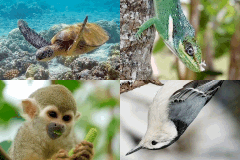AnAge entry for Apis mellifera
Classification (HAGRID: 00006)
- Taxonomy
-
Kingdom: Animalia
Phylum: Arthropoda (Taxon entry)
Class: Insecta (Taxon entry)
Order: Hymenoptera
Family: Apidae
Genus: Apis
- Species
- Apis mellifera
- Common name
- Honey bee
Lifespan, ageing, and relevant traits
- Maximum longevity
- 8 years
- Source
- ref. 812
- Sample size
- Medium
- Data quality
- Acceptable
- Observations
As in other social insects, workers and queens have distinct lifespans in the honey bee. Queens have been reported to live up to 8 years. Workers have a short lifespan due to foraging but can live 0.2-0.4 years if prevented from foraging. In the winter, workers can develop into a stress-resistant form called the "diunitus" and live up to 0.9 years [0812]. As workers age there is a decline in cellular degradation activity [1166].
Life history traits (averages)
- No information is available on life history. Please contact us if you wish to suggest or contribute data.
Metabolism
No information on metabolism is available.
References
- [1166] Hsu et al. (2014), Changes in cellular degradation activity in young and old worker honeybees (Apis mellifera) (PubMed)
- [1143] Nussey et al. (2013), Senescence in natural populations of animals: widespread evidence and its implications for bio-gerontology (PubMed)
- [0902] Aamodt (2009), Age-and caste-dependent decrease in expression of genes maintaining DNA and RNA quality and mitochondrial integrity in the honeybee wing muscle (PubMed)
- [0831] Ward et al. (2008), Age, caste, and behavior determine the replicative activity of intestinal stem cells in honeybees (Apis mellifera L.) (PubMed)
- [0830] Williams et al. (2008), Age and natural metabolically-intensive behavior affect oxidative stress and antioxidant mechanisms (PubMed)
- [0828] Kucharski et al. (2008), Nutritional control of reproductive status in honeybees via DNA methylation (PubMed)
- [0808] Behrends et al. (2007), Cognitive aging is linked to social role in honey bees (Apis mellifera) (PubMed)
- [0806] Amdam et al. (2007), Variation in endocrine signaling underlies variation in social life history (PubMed)
- [0741] Rueppell et al. (2007), Regulation of life history determines lifespan of worker honey bees (Apis mellifera L.) (PubMed)
- [0805] Patel et al. (2007), The making of a queen: TOR pathway is a key player in diphenic caste development (PubMed)
- [0812] Haddad et al. (2007), Extended longevity of queen honey bees compared to workers is associated with peroxidation-resistant membranes (PubMed)
- [0847] Corona et al. (2007), Vitellogenin, juvenile hormone, insulin signaling, and queen honey bee longevity (PubMed)
- [0815] Seehuus et al. (2006), Cellular senescence in honey bee brain is largely independent of chronological age (PubMed)
- [0408] Seehuus et al. (2006), Reproductive protein protects functionally sterile honey bee workers from oxidative stress (PubMed)
- [0407] Amdam et al. (2005), Social reversal of immunosenescence in honey bee workers (PubMed)
- [0848] Corona et al. (2005), Gene expression patterns associated with queen honey bee longevity (PubMed)
- [0063] Omholt and Amdam (2004), Epigenetic regulation of aging in honeybee workers (PubMed)
- [0908] Page and Peng (2001), Aging and development in social insects with emphasis on the honey bee, Apis mellifera L (PubMed)
External Resources
- Integrated Taxonomic Information System
- ITIS 154396
- Animal Diversity Web
- ADW account
- Encyclopaedia of Life
- Search EOL
- NCBI Taxonomy
- Taxonomy ID 7460
- Entrez
- Search all databases
- Ageing Literature
- Search Google Scholar or Search PubMed
- Images
- Google Image search
- Internet
- Search Google

